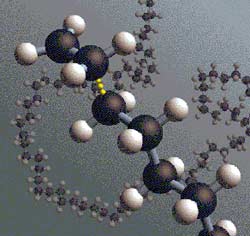Researchers have successfully developed an improved polymer device capable of detecting small amounts of explosive vapor. This work is detailed in the journal
 |
|
Polymer Molecule (Image: greenfacts) |
“Nature” (May 14, 2005), which could lead to the creation of ultra-sensitive sensors to detect explosives and bombs.
The invention team includes Aimeée Rose and colleagues at MIT (Massachusetts Institute of Technology, USA), who utilized a type of synthetic material commonly known as semiconducting organic polymer (SOP) in their design. When exposed to laser light, this compound produces a unique “secondary” light, a process known as laser emission (lasing). Molecules of explosives such as TNT (trinitrotoluene) lack electrons and are attracted to the electron-rich polymer. When they adhere to the surface, they interfere with the laser emission process, resulting in a decrease in the light efficiency of the SOP. By measuring the change in laser emission, scientists can easily detect TNT at concentrations below 5 parts per billion.
The team has also successfully identified DNT (dinitrotoluene) at a concentration of 100 parts per billion in just… 1 second. SOP has previously been used to locate damage-causing mines. However, the new device offers a sensitivity (to explosive vapors) 30 times greater than older models and boasts an accuracy of over 98%.
Lệ Đào


















































